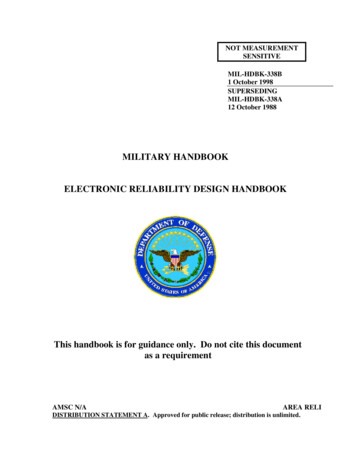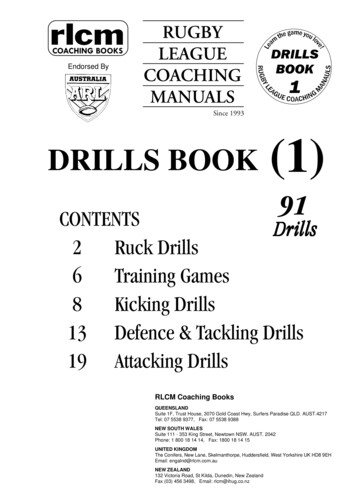
Transcription
THE WORST-CASE SCENARIOSurvival Handbook
TheWORST-CASE SCENARIOSurvival HandbookBy Joshua Piven and David BorgenichtC H R O N I C L EBOOKSSAN F R A N C I S C O
The authors wish to thank all the expertswho contributed to the making of this book,as well as Jay Schaefer, Laura Lovett, SteveMockus, and the entire team at Chronicle Books.Copyright 1999 by book soup publishing, inc.All rights reserved. No part of this book may be reproduced inany form without written permission from the publisher.Library of Congress Cataloging-in-Publication Data available.ISBN 0-8118-2555-8Printed in the United States of AmericaDesigned by book soup publishing, inc.Typeset in Adobe Caslon, Bundesbahn Pi, and Zapf DingbatsIllustrations by Brenda Browna book soup publishing bookDistributed in Canada by Raincoast Books9050 Shaughnessy StreetVancouver, British Columbia V6P 6E520 19 18 17 16 15 14 13 12Chronicle Books LLC85 Second StreetSan Francisco, California 94105www.chroniclebooks.com
WARNINGWhen a life is imperiled or a dire situation is athand, safe alternatives may not exist. To deal withthe worst-case scenarios presented in this book,we highly recommend—insist, actually—that thebest course of action is to consult a professionallytrained expert. Do NOT ATTEMPT TO UNDERTAKEANY OF THE ACTIVITIES DESCRIBED IN THIS BOOKYOURSELF. But because highly trained professionalsmay not always be available when the safety ofindividuals is at risk, we have asked experts onvarious subjects to describe the techniques theymight employ in those emergency situations. THEPUBLISHER, AUTHORS, AND EXPERTS DISCLAIMANY LIABILITY from any injury that may result fromthe use, proper or improper, of the informationcontained in this book. All the information in thisbook comes directly from experts in the situationat hand, but we do not guarantee that the information contained herein is complete, safe, or accurate,nor should it be considered a substitute for yourgood judgment and common sense. And finally,nothing in this book should be construed or interpreted to infringe on the rights of other personsor to violate criminal statutes: we urge you to obeyall laws and respect all rights, including propertyrights, of others.—The Authors
CONTENTSForeword by "Mountain"Preface. .14Great Escapes and Entrances. . .17How to Escape from Quicksand. 18How to Break Down a Door. 20How to Break into a Car. 24How to Hot-wire a Car. 28How to Perform a Fast 180-Degree Turnwith Your Car. 31How to Ram a Car. .34How to Escape from a Sinking Car. .36How to Deal witha Downed Power Line. .39The Best Defense. 41How to Survive a Poisonous Snake Attack. 42How to Fend Off a Shark.46How to Escape from a Bear. .50How to Escape from a Mountain Lion. 54
How to Wrestle Free from an Alligator.57How to Escape from Killer Bees.60How to Deal with a Charging Bull.64How to Win a Sword Fight.66How to Take a Punch. .69Leaps of Faith.73How to Jump from a Bridge or Cliff intoa River.74How to Jump from a Building intoa Dumpster.77How to Maneuver on Top of a Moving Trainand Get Inside.79How to Jump from a Moving Car.82How to Leap from a Motorcycle to a Car.84Emergencies. 87How to Perform a Tracheotomy.88How to Use a Defibrillatorto Restore a Heartbeat.91How to Identify a Bomb.94How to Deliver a Baby in a Taxicab.99
How to Treat Frostbite.103How to Treat a Leg Fracture. .106How to Treat a Bullet or Knife Wound.109Adventure Survival.113How to Land a Plane.114How to Survive an Earthquake. 120How to Survive Adrift at Sea. 125How to Survive When Lost in the Desert.129How to Survive If Your ParachuteFails to Open.l37How to Survive an Avalanche. 140How to Survive If You Are in the LineofGunfire.l43How to Survive When Lostin the Mountains. .146How to Make Fire Without Matches. 150How to Avoid Being Struck by Lightning. 155How to Get to the SurfaceIf Your Scuba Tank Runs Out of Air.l60The Experts. 163About the Authors.176
FOREWORDTHE RULES OF SURVIVALBy "Mountain" Mel DeweeseI am a Survival Evasion Resistance EscapeInstructor. I have developed, written, attended,and taught courses around the world to morethan 100,000 students—civilians, naval aviators,and elite Navy SEAL teams. I have more than30 years of survival training experience, fromthe Arctic Circle to the Canadian wilderness,from the jungles of the Philippines to theAustralian desert.Let's just say that I've learned a few thingsabout survival over the years.Whatever the situation, whether you're outin the mountains, on board a plane, or drivingcross-country, to "survive" means "To outlive, toremain alive or in existence; live on. To continueto exist or live after." After all, that's what it'sreally all about—about continuing to exist, nomatter how dire the circumstances. You have to be prepared—mentally, physically,and equipment-wise.I would have to call my training in the
Arctic Circle the ultimate survival adventure.The Arctic is an extremely harsh and unforgivingenvironment, and yet the Inuit people (Eskimos)not only survive, they live here at the top ofthe world. Most of the items you need for Arcticsurvival must come with you when you go—the Arctic offers little for improvisation.One morning, as we huddled inside ourigloo drinking tea to warm up, I noticed thatour senior Inuit guide drank several more cupsof tea than the rest of us. "He must be thirsty,"I thought. We then proceeded outside for ourmorning trek across the frozen landscape. Afterwe reached our camp, the senior instructorwalked over to a small knoll. Our young Inuitguide interpreted his words: "This is where thefox will come to seek a high lookout point. Thisis a good place to set a trap." The older manthen took out his steel trap, set it, laid out thechain, and to my surprise, urinated upon theend of the chain!The younger instructor explained: "That'swhy he drank all that tea this morning—toanchor it!" Indeed, the chain had frozen securelyto the ground.The lesson: Resources and improvisationequals survival.
You must not ignore the importance of themental aspects of survival; in particular, you muststay calm and you must not panic. And rememberthat willpower is the most crucial survival skillof all—don't catch that terrible disease of "Giveup-itis." All these mental strengths especiallycome into play when someone makes a mistake—which is inevitable.One trip into the jungles of the Philippines,our old guide Gunny selected and gathered variousplants while we were trekking. Upon arrival atthe camp, Gunny skillfully prepared bamboo to usefor cooking tubes. To these he added leaves, snails(he claimed only the old men catch snails becausethey are slow—young men catch fast shrimp),and a few slices of green mango. He also addeda few things I could not discern. Topping this offwith leaves from the taro plant, he added waterand placed the bamboo cooking tube on the fire.After the jungle feast, we settled intothe darkness for sleep. During the night, Iexperienced pain, contraction, and itching inmy throat. We were in pitch darkness, far fromcivilization, and my airways were progressivelyclosing. The following morning, the conditionworsened and my breathing was becoming restricted. I questioned the instructor, and he agreed he
had the same problem. That we shared ourdistress was reassuring and it led to our determining the source of the problem. It turned outwe had not boiled the taro leaves long enough.Recovering hours later, I mentally logged this asa lesson learned the hard way: Even the old manof the jungle can make mistakes.We all make mistakes. Overcoming them issurvival as well. You must have a survival plan. And yourplan should consider the following essentialelements: food, fire, water, and shelter, as wellas signals and first aid.I remember a military survival training courseI took in another jungle. A tropical environmentis one of the easiest to survive, if you know whereto look. It offers all of the needs for survival—food, fire, water, shelter. We needed water badlybut could not head for the major streams, rivers,or bodies of water to quench our thirst, as the"enemy" was tracking us. The enemy knew ourdire need for water, and he would be watchingthose areas. Looking into the jungle foliage, ourguide Pepe pulled his jungle bolo (a large knife)from its wooden case and pointed to a thick,grapelike vine, 3-4 inches in diameter. He cut the
vine at the top, then sliced off a 2-3 foot section,motioned to me, and held it above my parchedlips. Excellent! In total, it produced almost a largeglass of water. Then he cut into a rattan vine thatprovided nearly the same amount.That evening we tapped into the trunk ofa taboy tree, placed bamboo tube reservoirs wehad constructed beneath the tap, and left themovernight. Early the next morning, I was surprisedto find 6-8 quarts of water in our reservoirs.The next morning in the rain, Pepe stopped tocut a tall bundle of grass. He selected a smoothbarked tree and wrapped the grass around thetree to form a spigot. He then placed his bamboodrinking cup under the grass spigot. I was notconvinced about the quality of his filter, but it wasa good way for us to gather rainwater. That night,after we had reached the safe area, the jungledarkness fell upon us and we sat in the flicker ofthe bamboo fire. Pepe smiled at me and said,"Once again we've evaded the enemy and learnedto return."That simple phrase became our motto—andin fact, is the motto of every survival trainer,whether or not they know it. "Learn to return."This guide might help you do just that.
PREFACEAnything that can go wrong will.—Murphy's LawBe prepared.—Boy Scout mottoThe principle behind this book is a simple one:You just never know.You never really know what curves life willthrow at you, what is lurking around the corner,what is hovering above, what is swimmingbeneath the surface. You never know when youmight to be called upon to perform an act ofextreme bravery and to choose life or death withyour own actions.But when you are called, we want to be surethat you know what to do. And that is why wewrote this book. We want you to know what todo when the pilots pass out and you have to landthe plane. We want you to know what to dowhen you see that shark fin heading toward you.We want you to know how to make fire in thewilderness without any matches. We want you toknow what to do in these and in dozens of otherlife-threatening situations, from being forced to
jump from a bridge to being forced to jumpfrom a car, from taking a punch correctly tooutsmarting a charging bull, and from escapinga sniper to treating a bullet wound.We were not survival experts ourselves whenwe undertook this project—just regular, everydayfolk like you. Joshua grew up in the East—astreet-smart city boy. David grew up in the Westand spent his youth hiking and camping and fishing (even though his family used a Volkswagenvan most of the time). We were just a couple ofinquisitive journalists from different backgroundswho worried a lot and were interested in knowinghow to survive a variety of crisis situations, likelyor unlikely (mostly the latter). Together, we consulted experts in a variety of fields to compile thehandbook you have before you. The informationin this book comes directly from dozens of expertsources—stuntmen, physicians, EMT instructors,bomb squad officers, bullfighters, survival experts,scuba instructors, demolition derby drivers,locksmiths, sky divers, alligator farmers, marinebiologists, and avalanche rescue patrol members,to name a few.Within this book, you will find simple, stepby-step instructions for dealing with 40 life- andlimb-threatening situations, with instructive
illustrations throughout. We've also providedother essential tips and information—markedwith red bullets—that you must know. Anyand each of them could save your life. Everwonder how you would deal with the kinds ofsituations that usually only come up when youare a movie action hero? Now you can findout. And then, like the Boy Scouts, you too willbe prepared.So keep this book on hand at all times. It isinformative and entertaining, but useful, too. Geta copy and keep it in your glove compartment.Take it with you when you travel. Give a copyto your friends and loved ones. Because the BoyScouts know what they're talking about.And you just never know.—Joshua Piven and David Borgenicht
CHAPTERIGREAT ESCAPESAND ENTRANCES
HOW TO ESCAPEFROM QUICKSANDWhen walking in quicksand country, carrya stout pole—it will help you get out shouldyou need to.As soon as you start to sink, lay the pole on thesurface of the quicksand.Flop onto your back on top of the pole.After a minute or two, equilibrium in the quicksandwill be achieved, and you will no longer sink.Work the pole to a new position: under your hipsand at right angles to your spine.The pole will keep your hips from sinking, as you(slowly) pull out first one leg and then the other.Take the shortest route to firmer ground,moving slowly.How TO AVOID SINKINGQuicksand is just ordinary sand mixed with upwellingwater, which makes it behave like a liquid. However,quicksand—unlike water—does not easily let go. Ifyou try to pull a limb out of quicksand, you haveto work against the vacuum left behind. Here are afew tips:
The viscosity of quicksand increases withshearing—move slowly so the viscosity is as lowas possible. Floating on quicksand is relatively easy and isthe best way to avoid its clutches. You are morebuoyant in quicksand than you are in water.Humans are less dense than freshwater, andsaltwater is slightly more dense. Floating is easierin saltwater than freshwater and much easier inquicksand. Spread your arms and legs far apartand try to float on your back.When in an area with quicksand, bring a stout poleand use it to put your back into a floating position.Place the pole at a right angle from your spineto keep your hips afloat.
HOW TO BREAKDOWN A DOORINTERIOR DOORSGive the door a well-placed kick or two to the lockarea to break it down.Running at the door and slamming against it withyour shoulder or body is not usually as effective askicking with your foot. Your foot exerts more forcethan your shoulder, and you will be able to direct thisforce toward the area of the locking mechanism moresuccinctly with your foot.Alternate Method(if you have a screwdriver)Look on the front of the doorknob for a smallhole or keyhole.Most interior doors have what are called privacy sets.These locks are usually installed on bedrooms andbathrooms and can be locked from the inside whenthe door is shut, but have an emergency access hole inthe center of the door handle which allows entry tothe locking mechanism inside. Insert the screwdriveror probe into the handle and push the locking mechanism, or turn the mechanism to open the lock.
EXTERIOR DOORSIf you are trying to break down an exterior door, youwill need more force. Exterior doors are of sturdierconstruction and are designed with security in mind,for obvious reasons. In general, you can expect to seetwo kinds of latches on outside doors: a passage- orentry-lock set for latching and a dead-bolt lock forsecurity. The passage set is used for keeping the doorfrom swinging open and does not lock. The entrylock set utilizes a dead latch and can be locked beforeclosing the door.Exterior doors are ofsturdier construction.Kick at the point wherethe lock is mounted.
Give the door several well-placed kicks at the pointwhere the lock is mounted.An exterior door usually takes several tries to breakdown this way, so keep at it.Alternate Method(if you have a sturdy piece of steel)Wrench or pry the lock off the door by insertingthe tool between the lock and the door and pryingback and forth.Alternate Method(if you have a screwdriver, hammer, and awl)Remove the pins from the hinges (if the door openstoward you) and then force the door open from thehinge side.Get a screwdriver or an awl and a hammer. Place theawl or screwdriver underneath the hinge, with thepointy end touching the end of the bolt or screw.Using the hammer, strike the other end of the awl orscrewdriver until the hinge comes out.ASSESSING AMOUNT OF FORCE REQUIREDInterior doors in general are of a lighter constructionthan exterior doors and usually are thinner— 1 3/8"thick to 1 5/8" thick—than exterior doors, which generally are 1 3/4" thick. In general, older homes will bemore likely to have solid wood doors, while newerones will have the cheaper, hollow core models.Knowing what type of door you are dealing with will
help you determine how to break it down. You canusually determine the construction and solidity of adoor by tapping on it.HOLLOW CORE. This type is generally used forinterior doors, since it provides no insulation orsecurity, and requires minimal force. These doorscan often be opened with a screwdriver.SOLID WOOD. These are usually oak or some otherhardwood, and require an average amount of forceand a crowbar or other similar tool.SOLID CORE. These have a softwood inner framewith a laminate on each side and a chipped orshaved wood core, and require an average amountof force and a screwdriver.METAL CLAD. These are usually softwood witha thin metal covering, and require average or aboveaverage force and a crowbar.HOLLOW METAL. These doors are of a heaviergauge metal that usually has a reinforcing channelaround the edges and the lock mounting area,and are sometimes filled with some type ofinsulating material. These require maximum forceand a crowbar.
HOW TO BREAKINTO A CARMost cars that are more than ten years old have vertical, push-button locks. These are locks that comestraight out of the top of the car door and have rodsthat are set vertically inside the door. These locks canbe easily opened with a wire hanger or a Slimjim, orpicked, as described below. Newer cars have horizontal locks, which emerge from the side of the car doorand are attached to horizontal lock rods. These aremore difficult to manipulate without a special tool butcan also be picked.HOW TO BREAK INTO A CARWITH A HANGERTake a wire hanger and bend it into a long J.Square off the bottom of the J so the square isl 1/2 to 2 inches wide (see illustration).Slide the hanger into the door, between thewindow and the weather stripping.Open the door by feel and by trial and error. Feel forthe end of the button rod and, when you have it, pullit up to open the lock.
Take a wirehanger and bendit into a long ].Square offbottom.Slide hanger indoor between glassand weather stripping. Feel for theend of the buttonrod and lift up.HOW TO BREAK INTO A CARWITH A SLIMJIMA Slimjim is a thin piece of spring steel with a notch inone side, which makes it easy to pull the lock rod up.They can be purchased at most automotive supply stores.Slide the tool gently between the window and theweather stripping.
Some cars will give you only a quarter of an inch ofaccess to the lock linkage, so go slowly and be patient.Do not jerk the tool trying to find the lock rod.This can break the lock linkage, and on auto-locks itcan easily rip the wires in the door.Move the tool back and forth until it grabs the lockrod and then gently move it until the lock flips over.SlimjimSlide the Slimjim between the glass and the weather stripping.Feel for the lock rod. Move the tool back and forth gently untilthe lock flips over.
How TO PICK A CAR LOCKYou will need two tools—one to manipulate thepins or wafers inside the lock core and one to turnthe cylinder.You can use a small Allen wrench to turn the lock anda long bobby pin to move the pins and wafers. Keepin mind that many car locks are harder to pick thandoor locks. They often have a small shutter that covers and protects the lock, and this can make theprocess more difficult.While the bobby pin is in the lock, exert constantand light turning pressure with the wrench.This is the only way to discern if the pins or wafers—which line up with the notches and grooves in akey—are lined up correctly. Most locks have five pins.Move the bobby pin to manipulate the pins orwafers until you feel the lock turn smoothly.Alternate MethodUse a key from a different car from the samemanufacturer.There are surprisingly few lock variations, and thealien key may just work.Be AwareWe of course assume you are seeking to enter yourown car.
HOW TOHOT-WIRE A CARHot-wiring a car without the owner's permission isillegal, except in repossessions. Hot-wiring can bedangerous; there is a risk of electrical shock. Hotwiring will not work on all cars, particularly carswith security devices. Some "kill switches" can prevent hot-wiring.Open the hood.Locate the coil wire (it is red).To find it, follow the plug wires, which lead to the coilwire. The plug and coil wires are located at the rear ofthe engine on most V-8s. On six-cylinder engines, thewires are on the left side near the center of the engine,and on four-cylinder engines, they are located on theright side near the center of the engine.Run a wire from the positive ( ) side of the batteryto the positive side of the coil, or the red wire thatgoes to the coil.This step gives power to the dash, and the car will notrun unless it is performed first.Locate the starter solenoid.On most GM cars, it is on the starter. On Fords, it islocated on the left-side (passenger-side) fender well.
Run a wire from the positive ( ) sideof the battery to the red coil wire.to positive battery cableCross the terminals with a screwdriver or pliers (Ford).An easy way to find it is to follow the positive batterycable. You will see a small wire and the positive battery cable. Cross the two with a screwdriver or pliers.This cranks the engine.
Unlocking the Steering WheelPlace screwdriverat top center ofsteering column.GM solenoidIf the car has a standard transmission, make sureit is in neutral and the parking brake is on.If it has an automatic transmission, make sure it isin park.Unlock the steering wheel using a flat bladescrewdriver.Take the screwdriver and place it at the top center ofthe steering column. Push the screwdriver betweenthe steering wheel and the column. Push the lockingpin away from the wheel. Be very firm when pushingthe pin; it will not break.
HOW TOPERFORM A FAST180-DEGREE TURNWITH YOUR CARFROM REVERSEPut the car in reverse.Select a spot straight ahead. Keep your eyes on it,and begin backing up.Jam on the gas.Cut the wheel sharply ninety degrees around(a quarter turn) as you simultaneously drop thetransmission into drive.Make sure you have enough speed to use the momentum of the car to swing it around, but remember thatgoing too fast (greater than forty-five miles per hour)can be dangerous and may flip the car (and strip yourgears). Turning the wheel left will swing the rear ofthe car left; turning it right will swing the car right.When the car has completed the turn, step on thegas and head off.
From reverse'While backingup, jam onthe gas. Cut thewheel a quarterturn, andsimultaneouslydrop into drive.Vehiclepivots atthe rearwheelThe momentum of thecar effectuates the turn.at speeds no greater than 45mph
FROM DRIVEWhile in drive, or a forward gear, accelerate to a moderaterate of speed (anything faster than forty-five miles per hourrisks flipping the car).Slip the car into neutral to prevent the front wheelsfrom spinning.Take your foot off the gas and turn the wheel ninety degrees(a quarter turn) while pulling hard on the emergency brake.As the rear swings around, return the wheel to its originalposition and put the car back into drive.Step on the gas to start moving in the direction fromwhich you came.Be Aware The 180-degree turn while moving forward is moredifficult for the following reasons: It is easier to swing the front of the car around, because it isheavier and it will move faster with momentum. It is harder to maintain control of the rear of the car—it islighter and will slip more easily than the front. Spinningout of control, or flipping the car, are potential dangers. Road conditions can play a significant role in thesuccess—and safety—of this maneuver. Any surface without sufficient traction (dirt, mud, ice, gravel) will makequick turns harder and collisions more likely.
HOW TORAM A CARRamming a car to move it out of your way is not easyor safe, but there are some methods that work betterthan others and some that will minimize the damageto your vehicle. Keep in mind that the best way to hita car blocking your path is to clip the very rear of it,about one foot from the rear bumper. The rear is thelightest part of a car, and it will move relatively easily.Hitting it in the rear can also disable the car—withthe rear wheel crushed, you have time to get awaywithout being pursued.Disable your air bag, if you can.It will deploy on impact and will obstruct your viewafter it deploys.Wear a seat belt.Accelerate to at least twenty-five miles per hour.Do not go too fast—keeping the car at a slow speedwill allow you to maintain control without slowingdown. Then, just before impact, increase your speed togreater than thirty miles per hour to deliver a disablingcrunch to the rear wheel of the obstacle car.Ram the front passenger side of your car into theobstacle car at its rear wheel, at a ninety-degreeangle (the cars should be perpendicular).
If you are unable to hit a car in the rear, go for thefront corner.Avoid hitting the car squarely in the side; this will notmove it out of your way.The car should spin out of your way—hit the gas,and keep moving.Ram the obstacle car with thepassenger side of your car, anddeliver a disabling crunch to itsrear wheel.If you are unable to hit the car inthe rear, go for the right corner.
HOW TOESCAPE FROMA SINKING CARAs soon as you hit the water, open your window.This is your best chance of escape, because openingthe door will be very difficult given the outside waterpressure. (To be safe, you should drive with the windows and doors slightly open whenever you are nearwater or are driving on ice.) Opening the windowsallows water to come in and equalize the pressure.Once the water pressure inside and outside the car isequal, you'll be able to open the door.If your power windows won't work or you cannotroll your windows down all the way, attempt tobreak the glass with your foot or shoulder or a heavyobject such as an antitheft steering wheel lock.Get out.Do not worry about leaving anything behind unless itis another person. Vehicles with engines in front willsink at a steep angle. If the water is fifteen feet ordeeper, the vehicle may end up on its roof, upsidedown. For this reason, you must get out as soon aspossible, while the car is still afloat. Depending on thevehicle, floating time will range from a few seconds toa few minutes. The more airtight the car, the longer itfloats. Air in the car will quickly be forced out
As soon as you hit the water open your window. Otherwise, thepressure of the water will make it very difficult to escape.If you were unable to exit before hitting the water, attempt tobreak a window with your foot or a heavy object.through the trunk and cab, and an air bubble isunlikely to remain once the car hits bottom. Get outas early as possible.If you are unable to open the window or break it,you have one final option.Remain calm and do not panic. Wait until the carbegins filling with water. When the water reaches your
head, take a deep breath and hold it. Now the pressureshould be equalized inside and outside, and you shouldbe able to open the door and swim to the surface.How TO AVOID BREAKINGTHROUGH THE ICE Cars and light trucks need at least eight inches ofclear, solid ice on which to drive safely. Driving early or late in the season is not advisable. Leaving your car in one place for a long period oftime can weaken the ice beneath it, and cars shouldnot be parked—or driven—close together. Cross any cracks at right angles, and drive slowly. New ice is generally thicker than old ice. Direct freezing of lake or stream water is strongerthan refreezing, freezing of melting snow, orfreezing of water bubbling up through cracks. If there is a layer of snow on the ice, beware: alayer of snow insulates the ice, slowing the freezingprocess, and the snow's weight can decrease thebearing capacity of the ice. Ice near the shore is weaker. River ice is generally weaker than lake ice. River mouths are dangerous, because the ice nearthem is weaker. Carry several large nails in your pocket, and alength of rope. The nails will help you pull yourselfout of the ice, and the rope can be thrown tosomeone on more solid ice, or can be used to helpsomeone else.
HOW TO DEALWITH A DOWNEDPOWER LINEHigh-voltage power lines, which carry power fromplants and transformers to customers, can come crashing down during severe storms. If you are in a car whena pole or line falls, you are much safer remaining insidea grounded vehicle than being on foot. If the wire fallson the car, do not touch anything—wait for help.Assume that all power lines, whether sparking or not,are live.Stay far away from downed lines.Current can travel through any conductive material, andwater on the ground can provide a "channel" from thepower line to you. An electrical shock can also occur whenone comes in contact with the charged particles near ahigh-voltage line; direct contact is not necessary for electrocution to occur. Never touch a vehicle that has come incontact with a live wire—it may still retain a charge.Do not assume that a nonsparking wire is safe.Often, power may be restored by automated equipment,causing a "dead" wire to become dangerous. Stay awayfrom downed lines even if you know they are not electriclines—the line could have come in contact with an electric line when it fell, causing the downed line to be "hot."
If a person comes into contact with a live wire, use anonconductive material to separate the person fromthe electrical sou
Survival Handbook. The WORST-CASE SCENARIO Survival Handbook By Joshua Piven and David Borgenicht CHRONICLE BOOKS SAN FRANCISCO. The authors wish to thank all the experts who contributed to the making of this book, as well as Jay Schaefer, Laura Love










